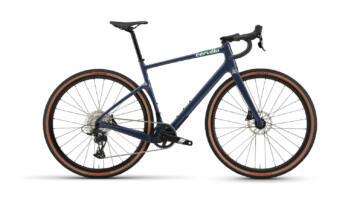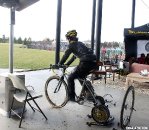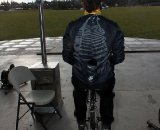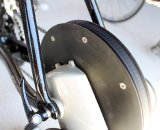by Andrew Yee
Though the name Greg LeMond is ubiquitous – for a variety of reasons – in American cycling, the three-time Tour de France winner and former World Champion doesn’t come up as much in ’cross talk. Yet LeMond has a fond place in his heart for cyclocross (check out our feature article on LeMond and his backyard cyclocross course in Cyclocross Magazine Issue 11), and with the new LeMond Fitness Revolution trainer, you just might be seeing the former champ’s name cropping up in the tents around the course.
We recently had the chance to check out this new trainer just as we were trying our best to avoid putting on the extra post-nationals and holiday pounds. Perhaps you have the same need at this time of year? Does the LeMond Fitness Revolution trainer live up to its name and revolutionize your pre-race warm-ups and basement intervals? Read on to find out.
Back when he was taking his first steps into the pro ranks, LeMond wasn’t satisfied with the existing trainers on the market, lamenting their lack of ‘road feel.’ So he worked with neighbor and inventor Larry Brown, and together they built an early prototype of the current Revolution trainer, which LeMond took to Belgium and credits with allowing him to train aggressively despite the inclement weather. Over the years, he held on to that favored trainer, but it’s been sitting in his attic while he focused on his bicycle business. However, after LeMond parted ways with Trek, he dusted off the old design and decided to refine it and see if others would appreciate the design as much as he did.
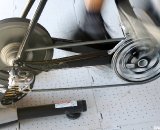
The bike attaches directly to a cassette on the trainer - no rear wheel necessary! © Cyclocross Magazine
The Technology:
The basic idea behind the trainer is the “Direct Drive,” meaning that you remove your rear wheel and attach your bike to the trainer via its own cassette. The obvious advantage here for cyclcrossers is that the system eliminates the need for a spare wheel or the tearing up of your precious but fragile cyclocross tubulars. Warm up on your race rig, then throw your wheel back on and you’re ready to go. No knobby tire buzz, no swapping wheels, no cumbersome resistance adjustment unit to clamp to your bars.
The rear hub ends up driving the resistance unit via a belt drive, and it’s the resistance unit that’s the real story here. The Revolution utilizes a huge fan that has quite a bit of mass, essentially creating a flywheel and a fan in one. The fan’s mass is the main reason the Revolution is so much heavier than your average magnetic or fluid trainer, and all that mass translates into a more even spin that continues for a while after pedaling ceases. When you stop pedaling, the fan continues to spin, even if you are coasting, and there’s no brake to stop it quickly. (Thankfully, the fan unit is enclosed to help prevent accidents with curious fingers, but you shouldn’t have kids near your trainer while in use anyway.)
Setting it up:
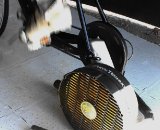
The LeMond Fitness Revolution trainer takes a new approach to stationary design. © Cyclocross Magazine
The Revolution is a sturdy but heavy piece of equipment at 32 pounds. That’s nearly double what a typical fluid trainer weighs. At a race, when parking is far from your tent, this may be an issue, as it also does not fold or lend itself to easy carrying. But then again, you’re also not schlepping an extra rear wheel. Because it doesn’t fold, it’s very rigid and stable, and its four adjustable feet help make this a very stable trainer even under sprinting when on uneven terrain – whether that be a sloping basement or a high-school soccer field.
Since the Revolution uses its own cassette, just like when using a different rear wheel, you might have to make minor tweaks to rear derailleur cable tension or limit screws to get perfect shifting on the trainer. This isn’t a big deal if you’re used to doing these types of adjustments, but it requires some attention. Warming up until the very last second and forgetting to readjust before shooting for that holeshot could cost you. If you do your own wrenching, it shouldn’t be an issue…our experience was that at most a few turns of the rear derailleur cable barrel adjuster was all we needed to get shifting to be precise.
The trainer comes with a Shimano 10s cassette, but Campagnolo options are available. If you’re running an old-school rig, you can buy the unit without a cassette and put on your own 8 or 9-speed cassette, or even a 7-speed cassette with a spacer, without much difficulty.
The Ride:
The LeMond Fitness Trainer really is quite revolutionary in terms of feel for a rear-mounted trainer. The massive fan creates a real ‘road feel’ that allows you to coast for brief periods of time without losing momentum. Start pedaling again and it’s not like you’re starting from zero – just like real-world riding. We were impressed how the Revolution’s design encourages and allows a very smooth pedaling motion – the resistance ramped up nicely and didn’t have the on/off feel or boxy pedal strokes of magnetic trainers. It was, in short, the closest to real-world riding we’ve ever felt on a trainer. The feel is similar to the Kreitler Killer Headwind on rollers, but the Revolution trainer, unlike rollers, makes it far easier to stand up to sprint or give your bum a long break. A nice touch is that the ‘normal’ height of the mount means there isn’t a need for a front-wheel block.
Just like the Kreitler Killer Headwind unit, however, this thing can get quite loud. Be prepared to install an extra set of speakers to hear the TV over the trainer during intervals, and possibly lose the rights to ride after 9PM. This is mostly due to wind noise of the massive fan, but on our early test unit, it was pretty loud even when not riding all-out. I had to crank up the mp3 player to hear my music even when just spinning at a moderate clip.
LeMond Fitness acknowledges early units were loud even under moderate pedaling, but has since changed the bearing design to address this complaint, and says the newer units have much lower noise when not pedaling at full power. Still, don’t plan a full sprint while the baby is sleeping or if you have close neighbors, as that fan moves quite a bit of air under an all-out effort.
Adding to the ‘road feel’ is how well resistance is modulated by shifting. Just shift, and the increased rpms on the fan translate into increased resistance on the pedals. No turning knobs or funky cable-actuated resistance units just to do an interval. Of course, this means training on a single-speed locks you into a single level of tension, something to consider for you Golden Speedo seekers who are already training for the 2011 SSCXWC in San Francisco.
It’s incredibly intuitive that you just need to shift your own gears to adjust the resistance of the unit, and all-out efforts don’t require any adjustment other than slamming it into your biggest gear. However, it’s worth noting that on a 46×12, the fan/resistance was just enough for our mortal power – and we’re certainly far from the Elite ranks. For a pre-race warm-up, unless you’re trying to set a personal wattage record, the resistance is probably more than adequate. And with road gearing, all but the strongest riders should be satisfied. But If you’re a watt-monster and doing all your indoor training with cyclocross gearing, you might actually yearn for more resistance. LeMond Fitness says they’re considering a “pro” model with higher resistance, but an easy adjustment would be to install a cassette with an 11-tooth cog onto the trainer.
In the Works:
For those of you who train with power (and check out our article in Issue 11 on understanding power-based training if you do), the Revolution will soon have an option that uses ANT+ standards to transmit data, including estimated power (calculated from temperature, altitude, humidity and the fan speed), cadence and speed, via a small attachment at the back of the unit. LeMond Fitness transmits the data to an ANT+ head unit that mounts on the front tire – in a natural line of sight when your tongue is swinging back and forth. The data unit, expected to be available in February, will transmit data to any ANT+-equipped fitness watch (but not a third party power unit yet). It allows for a flash drive download of ride data, and will be compatible with Training Peaks workouts.
The Verdict:
The LeMond Fitness trainer is an ideal cycling trainer for a cyclocrosser, for both pre-race warm-ups and indoor training. It’s agnostic to the type of bike or tire you’re riding, and does a great job of mimicking the feel of actually riding your bike on the road (or ’cross course, without the bumps). It’s such a good riding experience that it actually got a few of us indoor-workout haters to want to ride the trainer more, despite the noise. It’s not cheap for sure, but it’s worth noting that it might save you money over time in tires, especially if you often ride your knobbies on the trainer before races. At the 2010 USA Cycling Cyclocross National Championships, LeMond Fitness provided a slew of trainers for racers to use for warm-ups, and for the bigger races they were all reserved. Though the cost might dissuade many, their popularity in Bend might be a sign that we’ll be seeing a lot more of them at cyclocross races.
Psyched:
- Best road feel of any trainer
- Saves our precious knobbies
- No need for an extra wheel or road tire
- Intuitive resistance adjustment (just your shifters)
Bummed:
- Neighbor-unfriendly loud (but new models are supposed to be much quieter)
- Heavy and does not fold
- Not cheap
LeMond Fitness Revolution Trainer
MSRP: $499.00 without cassette; $549.00 with Shimano 10s cassette
For more info: www.lemondfitness.com
Photo Gallery:











